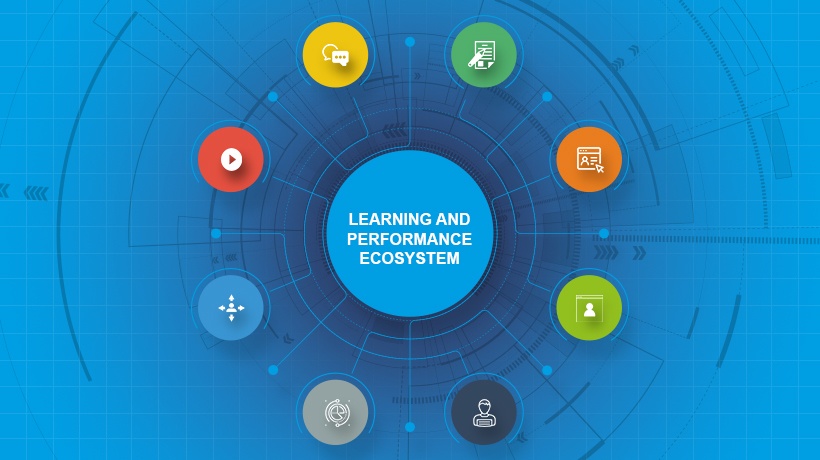More Direct, Effective, And Instantly Available
Today’s work environment is more distributed and diffuse than ever before. It is also more connected. Mobile devices allow us to work almost anywhere. We converse digitally, meet virtually, and collaborate in online environments. Working remotely has been normalized during the global pandemic. At the same time, we are constantly dealing with rapid change, information explosion, and increased variation and complexity in our work. These and other factors are driving the Learning and Development (L&D) business function toward an evolutionary leap that will ultimately change how it operates, the solutions it delivers, and the impact it has on business success.
Though still important and useful, the traditional training approach is no longer enough. L&D must bring a bigger toolbox to support learning, performance, and productivity. Learning solutions must be more direct, effective, and instantly available—that is, directly relevant to the task at hand, effective at enabling successful performance, and instantly available for use when it is needed. L&D must do better at connecting people, not just with relevant instruction, but also with real-time answers and information, on-the-job guidance, opportunities to share with colleagues, and pathways toward professional development. For all this, a comprehensive learning and performance ecosystem is needed.
Ecosystem Defined
Too often, people think of a learning ecosystem as technology. While enabled by technology, a learning ecosystem is much more. It is an environment that integrates working and learning seamlessly. It connects people with knowledge, guidance, learning, colleagues, and experts in ways that optimize individual performance and organizational productivity.
In nature, an ecosystem is defined as the connections between living organisms in a shared environment. The environment must provide the right combination of air, water, heat, and light to support the ecosystem and help it thrive. In business, a learning and performance ecosystem can be defined as the connections between professionals in a shared work environment that supports learning, performance, productivity, and professional development with the right combination of content, processes, and technology.
For workers, the ecosystem provides mechanisms for learning, professional development, information, guidance, diagnostics, tools, and other types of job support. For L&D professionals, the ecosystem is a bigger toolbox that requires an expanded set of processes, content, technology, and, perhaps most importantly, an expanded skillset. The ecosystem requires L&D to be masters of performance analysis, problem-solving, a broad set of design concepts and capabilities, and methods for measuring impact. This is the first in a series of articles that will attempt to address the various facets of the modern learning and performance ecosystem.
The 6 Components Of A Learning And Performance Ecosystem
A modern learning and performance ecosystem places people in the center and surrounds them with six components, each representing an approach to Learning and Development: talent management, performance support, knowledge management, access to experts, social networking and collaboration, and structured learning. These approaches can be applied individually or used in any combination to provide a comprehensive solution for improving human performance and productivity. 
Figure 1: The six components of a learning and performance ecosystem
- Talent management
Talent management solutions can include many features. The most relevant to the learning ecosystem are career development tools, such as competency-based self-assessment, 360 feedback, and personal professional development plans. - Performance support
Performance support solutions provide information, diagnostics, and guidance in the flow of work. Examples include decision support tools, chatbots, intelligent coaches, digital adoption solutions, and Augmented Reality solutions. - Knowledge management
Knowledge management provides a searchable repository of highly relevant, curated information in the form of a knowledge base or wiki. Content can include policies and procedures, information about products and services, quality standards, sample work outputs, tools and templates, market intelligence, competitor information, and much more. - Access to experts
Having this taps the knowledge and experience that is distributed throughout an organization. These solutions connect the people who need to know with the people who know. They include expert directories, expert consultation services, and expertise location and management solutions. - Social networking and collaboration
Social networking and collaboration enable people to learn from each other by sharing information, experience, and insight. These can include communities of practice, discussion forums, blogs and micro-blogs, and collaboration tools. - Structured learning
Structured learning solutions teach skills and knowledge with opportunities for practice, assessment, and reinforcement. Solutions include instructor-led, virtual, and web-based courses, immersive and adaptive learning simulations, instructional games, and microlearning.
Your organization’s learning ecosystem may not deploy all six components, at least not right away. Every ecosystem project offers opportunities to grow the ecosystem.
Two Examples
A multinational business equipment company engages its L&D department to help with its strategic transformation to executive solution selling. L&D provides a comprehensive solution that includes a performance support solution to assist sales representatives with each step of the solution selling process; a knowledge base containing market research, competitive analysis, and sales collateral to assist in preparation for customer meetings; a training workshop enabling sales representatives to practice selling to retired CEOs; and an online mentoring program.
A professional association engages its L&D group to increase member recruitment, retention, and engagement. After some data gathering and analysis, L&D identifies a set of solutions demanded by its membership. It aggregates the association’s informal learning content in a centralized knowledge base and applies a member-focused metadata taxonomy to tag the content, making it more easily discoverable through search. L&D then applies a machine learning-based recommendation engine to connect members with content most likely to be relevant to them personally. Next, L&D redesigns the training and assessments related to its professional certifications into a set of smaller micro-credentials.
Conclusion
Modern learning and performance ecosystems offer a powerful set of tools and approaches for professional Learning and Development. The learning and performance ecosystem model places people at the center and connects them with information, instruction, guidance, and other resources to help them learn and perform their work in ways that are more efficient and effective than ever before. Organizations can grow their ecosystem capabilities one solution at a time, gaining executive support and credibility from the success of each project.
Image Credits:
Image copyright Steve Foreman and Marc Rosenberg, Ph.D., 2014.







